|
The
Device That Changed the World
by
Bob Brooke
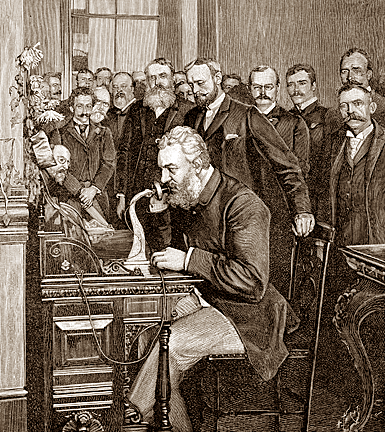 In
the summer of 1876 when Alexander Graham Bell introduced the telephone
to Americans at the Philadelphia Centennial Exposition, no one had any
idea how it would change their lives. When people think of antiques,
they imagine objects that people used in the past and perhaps don’t use
any more. But once telephones came on the scene, they evolved from
relatively clunky technology to the sleek rectangles that people carry
with them everywhere. In
the summer of 1876 when Alexander Graham Bell introduced the telephone
to Americans at the Philadelphia Centennial Exposition, no one had any
idea how it would change their lives. When people think of antiques,
they imagine objects that people used in the past and perhaps don’t use
any more. But once telephones came on the scene, they evolved from
relatively clunky technology to the sleek rectangles that people carry
with them everywhere.
Before the invention of electromagnetic telephones, mechanical acoustic
devices existed for transmitting speech and music over a greater
distance greater than that of normal direct speech. The earliest
mechanical telephones were based on sound transmission through pipes or
other physical media.
The Invention of the Telephone
The telephone emerged from the making and successive improvements of the
electrical telegraph. In 1804, Spanish polymath and scientist Francisco
Salva Campillo constructed an electrochemical telegraph. But it was
English inventor Francis Ronalds built the first working telegraph in
1816 and used static electricity. Baron Schilling created an
electromagnetic telegraph in 1832. Carl Friedrich Gauss and Wilhelm
Weber built another electromagnetic telegraph in 1833 in Göttingen.
Credit for the invention of the electric telephone is frequently
disputed. Charles Bourseul, Innocenzo Manzetti, Antonio Meucci, Johann
Philipp Reis, Alexander Graham Bell, and Elisha Gray have all been
credited with the telephone's invention. The early history of the
telephone became and still remains a confusing morass of claims and
counterclaims. The patents Alexander Graham Bell and Thomas Edison filed
were commercially decisive because they dominated telephone technology
and were upheld by U.S. court decisions.
Though the modern telephone is the
result of work of many people. Alexander Graham Bell was the first to
patent it as an "apparatus for transmitting vocal or other sounds
telegraphically." Bell has most often been credited as the inventor of
the first practical telephone.
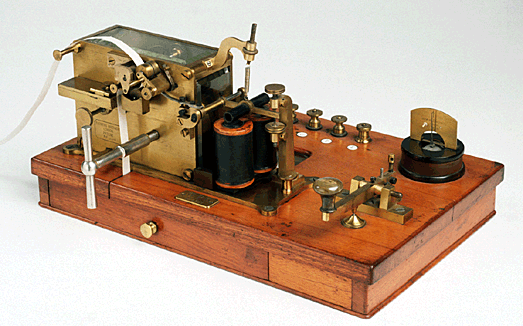
The main users of the electrical telegraph were post offices, railway
stations, the more important governmental centers (ministries), stock
exchanges, very few nationally distributed newspapers, the largest
internationally important corporations, and wealthy individuals used the
electrical telegraph. Telegraph exchanges worked mainly on a store and
forward basis. Although telephones devices were in use before the
invention of the telephone exchange, their success and economical
operation would not have been impossible with the structure of the
contemporary telegraph systems.
The Telephone Exchange
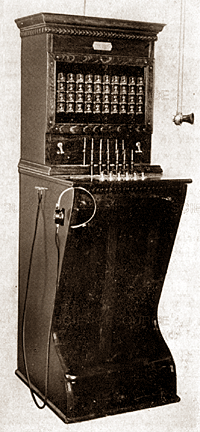 Prior
to the invention of the telephone switchboard, people connected their
homes to their businesses with pairs of telephones directly with each
other. A telephone exchange provides telephone service for a small area.
Either manually by operators, or automatically by machine switching
equipment, it interconnects individual subscriber lines for calls made
between them. This made it possible for subscribers to call each other
at homes, businesses, or public spaces. These made telephony an
available and comfortable communication tool for many purposes, and it
gave the impetus for the creation of a new industrial sector. Prior
to the invention of the telephone switchboard, people connected their
homes to their businesses with pairs of telephones directly with each
other. A telephone exchange provides telephone service for a small area.
Either manually by operators, or automatically by machine switching
equipment, it interconnects individual subscriber lines for calls made
between them. This made it possible for subscribers to call each other
at homes, businesses, or public spaces. These made telephony an
available and comfortable communication tool for many purposes, and it
gave the impetus for the creation of a new industrial sector.
Hungarian engineer Tivadar Puskás came up with the concept of the
telephone exchange in 1876 while he was working for Thomas Edison on a
telegraph exchange. The first commercial telephone exchange opened in
New Haven, Connecticut, with 21 subscribers on January 28, 1878, in a
storefront of the Boardman Building in New Haven, Connecticut. George W.
Coy designed and built the world's first switchboard for commercial use.
Alexander Graham Bell's lecture at the Skiff Opera House in New Haven on
April 27, 1877 influenced Coy.
Bell discussed the idea of a telephone exchange for conducting business
during which he demonstrated a three-way telephone connection with
Hartford and Middletown, Connecticut. On November 3,1877, Coy applied
for and received a franchise from the Bell Telephone Company for New
Haven and Middlesex Counties. Coy, along with Herrick P. Frost and
Walter Lewis, who provided the capital, established the District
Telephone Company of New Haven on 15 January 1878.
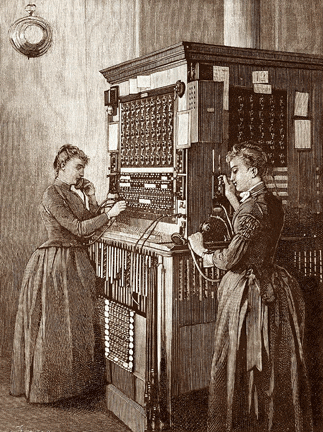 According
to one source, Coy built his switchboard of "carriage bolts, handles
from teapot lids and bustle wire." While the switchboard could connect
as many as 64 customers, only two conversations could be handled
simultaneously and six connections had to be made for each call. According
to one source, Coy built his switchboard of "carriage bolts, handles
from teapot lids and bustle wire." While the switchboard could connect
as many as 64 customers, only two conversations could be handled
simultaneously and six connections had to be made for each call.
The District Telephone Company of New Haven went into operation with
only 21 subscribers, who paid $1.50 per month. By February 21,1878, it
listed 50 by the time the company published its first telephone
directory. Most of these were businesses and listings such as
physicians, the police, and the post office. The directory listed only
eleven residences, four of which were for persons associated with the
company.
The New Haven District Telephone Company grew quickly. By 1880, it had
the right from the Bell Telephone Company to service all of Connecticut
and western Massachusetts.
Early Telephones
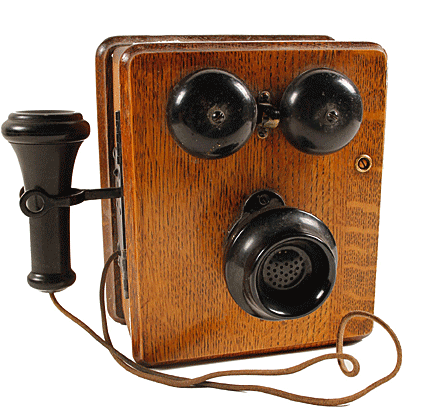 Early
telephones were technically diverse. Some of them used liquid
transmitters which soon went out of use. Others were dynamic: their
diaphragms vibrated a coil of wire in the field of a permanent magnet or
vice versa. Such sound-powered telephones survived in small numbers
through the 20th century in military and maritime applications where the
ability to create its own electrical power was crucial. Most, however,
used Edison/Berliner carbon transmitters, which were much louder than
the other kinds, even though they required induction coils. Early
telephones were technically diverse. Some of them used liquid
transmitters which soon went out of use. Others were dynamic: their
diaphragms vibrated a coil of wire in the field of a permanent magnet or
vice versa. Such sound-powered telephones survived in small numbers
through the 20th century in military and maritime applications where the
ability to create its own electrical power was crucial. Most, however,
used Edison/Berliner carbon transmitters, which were much louder than
the other kinds, even though they required induction coils.
A dynamic transmitters locally powered early telephones. Outside plant
personnel visited each telephone periodically to inspect the battery.
During the 20th century, the "common battery" operation came to
dominate. The telephone exchange powered the "talk battery" over the
same wires that carried the voice signals. Late in the century, wireless
handsets brought a revival of local battery power.
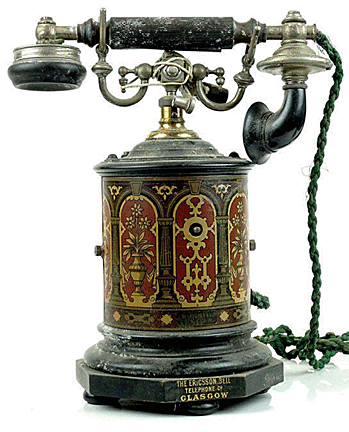 The
earliest telephones had only one wire for transmitting and receiving of
audio, and used a ground return path. The earliest dynamic telephones
also had only one opening for sound, and the user listened and spoke
into the same hole. Sometimes the instruments operated in pairs at each
end, making conversation more convenient but also more expensive. The
earliest telephones had only one wire for transmitting and receiving of
audio, and used a ground return path. The earliest dynamic telephones
also had only one opening for sound, and the user listened and spoke
into the same hole. Sometimes the instruments operated in pairs at each
end, making conversation more convenient but also more expensive.
At first, users didn’t use the benefits of a switchboard exchange.
Instead, they leased telephones in pairs to the subscriber, for example
one for his home and one for his shop, and the subscriber had to arrange
with telegraph contractors to construct a line between them. Users who
wanted the ability to speak to three or four different shops, suppliers
etc. would obtain and set up three or four pairs of telephones. Western
Union, already using telegraph exchanges, quickly extended the principle
to its telephones in New York City and San Francisco. Bell quickly
realized the potential
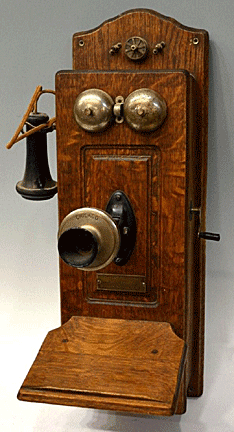 Signaling
began in an appropriately primitive manner. The user alerted the other
end, or the exchange operator, by whistling into the transmitter.
Exchange operation soon resulted in telephones being equipped with a
bell, first operated over a second wire and later with the same wire
using a condenser. Telephones connected to the earliest Strowger
automatic exchanges had seven wires, one for the knife switch, one for
each telegraph key, one for the bell, one for the push button and two
for speaking. Signaling
began in an appropriately primitive manner. The user alerted the other
end, or the exchange operator, by whistling into the transmitter.
Exchange operation soon resulted in telephones being equipped with a
bell, first operated over a second wire and later with the same wire
using a condenser. Telephones connected to the earliest Strowger
automatic exchanges had seven wires, one for the knife switch, one for
each telegraph key, one for the bell, one for the push button and two
for speaking.
Rural and other telephones that were not on a common battery exchange
had hand cranked "magneto" generators to produce an alternating current
to ring the bells of other telephones on the line and to alert the
exchange operator.
In 1877 and 1878, Edison invented and developed the carbon microphone
used in all telephones along with the Bell receiver until the 1980s.
After protracted patent litigation, a federal court ruled in 1892 that
Edison and not Emile Berliner was the inventor of the carbon microphone.
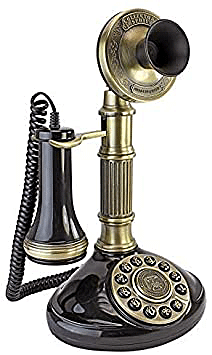 In
the 1890s a new smaller style of telephone appeared, the candlestick
telephone, and it was packaged in three parts. The transmitter stood on
a stand, known as a "candlestick" for its shape. When not in use, the
receiver hung on a hook with a switch in it, known as a "switchhook."
Previous telephones required the user to operate a separate switch to
connect either the voice or the bell. With the new kind, the user was
less likely to leave the phone "off the hook". In phones connected to
magneto exchanges, the bell, induction coil, battery, and magneto were
in a separate bell box called a "ringer box." In phones connected to
common battery exchanges, the ringer box was installed under a desk, or
other out of the way place, since it did not need a battery or magneto. In
the 1890s a new smaller style of telephone appeared, the candlestick
telephone, and it was packaged in three parts. The transmitter stood on
a stand, known as a "candlestick" for its shape. When not in use, the
receiver hung on a hook with a switch in it, known as a "switchhook."
Previous telephones required the user to operate a separate switch to
connect either the voice or the bell. With the new kind, the user was
less likely to leave the phone "off the hook". In phones connected to
magneto exchanges, the bell, induction coil, battery, and magneto were
in a separate bell box called a "ringer box." In phones connected to
common battery exchanges, the ringer box was installed under a desk, or
other out of the way place, since it did not need a battery or magneto.
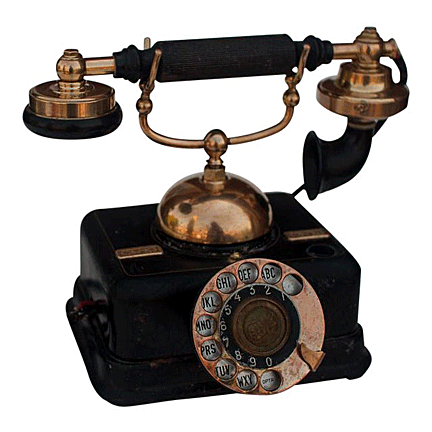 Cradle
designs also appeared at this time, with a handle with the receiver and
transmitter attached, separate from the cradle base that housed the
magneto crank and other parts. They were larger than the "candlestick"
and more popular. Cradle
designs also appeared at this time, with a handle with the receiver and
transmitter attached, separate from the cradle base that housed the
magneto crank and other parts. They were larger than the "candlestick"
and more popular.
Disadvantages of single-wire operation, such as crosstalk and hum from
nearby AC power wires, had already led to the use of twisted pairs and,
for long-distance telephones, four-wire circuits. Users at the beginning
of the 20th century did not place long-distance calls from their own
telephones but made an appointment to use a special sound-proofed
long-distance telephone booth furnished with the latest technology.
By 1904, exchanges connected over three million phones in the U.S. by
manual switchboard exchanges. By 1914, the U.S. was the world leader in
telephone density and had more than twice the teledensity of Sweden, New
Zealand, Switzerland, and Norway which had primarily exceeded them.
A Telephone Classic
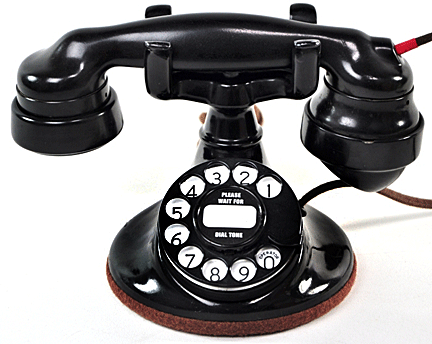 What
turned out to be the most popular and longest-lasting physical style of
telephone was introduced in the early 20th century, including Bell's
model 102 telephone. A carbon granule transmitter and electromagnetic
receiver were united in a single molded plastic handle, which when not
in use were placed in a cradle in the base unit. The circuit diagram of
the model 102 shows the direct connection of the receiver to the line,
while the transmitter was induction coupled, with energy supplied by a
local battery. The coupling transformer, battery, and ringer were in a
separate enclosure from the desk set. The rotary dial in the base
interrupted the line current by repeatedly but very briefly
disconnecting the line 1 to 10 times for each digit, and the hook switch
(in the center of the circuit diagram) permanently disconnected the line
and the transmitter battery while the handset was on the cradle. What
turned out to be the most popular and longest-lasting physical style of
telephone was introduced in the early 20th century, including Bell's
model 102 telephone. A carbon granule transmitter and electromagnetic
receiver were united in a single molded plastic handle, which when not
in use were placed in a cradle in the base unit. The circuit diagram of
the model 102 shows the direct connection of the receiver to the line,
while the transmitter was induction coupled, with energy supplied by a
local battery. The coupling transformer, battery, and ringer were in a
separate enclosure from the desk set. The rotary dial in the base
interrupted the line current by repeatedly but very briefly
disconnecting the line 1 to 10 times for each digit, and the hook switch
(in the center of the circuit diagram) permanently disconnected the line
and the transmitter battery while the handset was on the cradle.
Starting in the 1930s, the base of the telephone also enclosed its bell
and induction coil, obviating the need for a separate ringer box. Power
was supplied to each subscriber line by central-office batteries instead
of the user's local battery, which required periodic service. For the
next 50 years, the network behind the telephone grew progressively
larger and much more efficient, and, after adding the rotary dial, the
instrument itself changed little until Touch-Tone signaling started
replacing the rotary dial in the 1960s.
<
Back to Antiques Archives
Next Article > |
